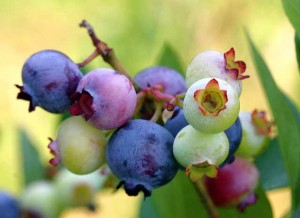
phreddieh3-wikipedia.org
Blueberry bushes, like any other plants, require attention after the initial planting stage. They area susceptible to pest and disease attacks, as well as problems with water retention in soil, soil compaction and need to be fertilized annually so that they have adequate amounts of nutrient supplements for growth and fruit development.
Weed Control
You need to control the growth of weeds, not only because do they compete with your blueberry plants for nutrients in the soil, some weeds will also compete for bees\’ attention which are important for cross-pollination of blueberries.
Prior to planting
Perennial weeds and grasses can be controlled because you start planting your planting blueberries by using non-residual herbicides. Follow the recommended rates as per required. If using herbicide is not your thing, you may also find alternatives in growing rye or other types of cover crops for one or two years at the site prior to planting blueberries. These cover crops will help reduce the number of weeds. They are also great for adding more organic matter to the soil.
First Year
During the first year after planting, DO NOT use herbicides. Control the growth of weeds by lightly cultivating your site. Lightly cultivate (about 1 to 2 inch deep will be sufficient) to prevent weed growth as any deeper cultivation will injure the roots of the blueberry.
Established Plantings
Once your garden has past the first year, you can start using herbicides as well as cultivation to control weed growth. Cultivation should be used for areas between rows, Use cover crops such as oats or rye between rows after harvest to suppress late-season weeds. These will also harden the blueberry bushes for winter and stop soil erosion. Use herbicide for weeds growing within rows.
Disease and Insect Control
Blueberries are susceptible to insect pests such as plum curculio, aphids, blueberry maggots, blueberry tip borer, cranberry fruitworm and leafrollers. Several applications of pesticide sprays may be required each year.
Blueberry diseases such as fungi, viruses and twig blight can be avoided by purchasing plants are grown from tissue culture instead of cuttings as the former are known to be more resistant to diseases. Do not over water your plant, and water in the early morning and not in the evening to that the plant foliage has time to dry. Too much moisture can cause fungi.
Note: While regular pruning helps control diseases, over-pruning will leave the blueberry bush weak and susceptible to pests and disease. (see section on pruning below).
Fertilization
Before you plant your blueberries, you will definitely need to run a soil test for pH, composition and texture. Make amendments are recommended based on the results of your test. Approximately a month after you\’ve planted your shrubs, sprinkle about an ounce of 20-0-10+5 (N-P-K-Mg) within 12 – 18 inches of each plant (avoid applying directly on the crown or stems).
For established plants, nitrogen (N) would be one of the most important elements you will need to re-apply each year. The amount you use depends on the age of your plant as well as the soil type in your garden. If the pH level of the soil drops below 5.0, use urea (which has 45% nitrogen). If it is above 5.0, use ammonium sulfate (21% N). Avoid using calcium nitrate, or any fertilizers containing chloride.
Apply the fertilizer on both sides of plants in broad strips before budbreak. If your site sits on sandy soil, apply half the amount before budbreak and half at petal fall.
Pruning
Regular pruning helps produce larger yields of fruits. If you do not prune the bushes, the energy and nutrients are not channeled to fruit development, causing a decline in vigor and fruitfulness. Pruning also helps reduce old canes and encourage the growth of new ones that will bear fruits. Canes that are 4 to 6 years old and 1 to 11/2 inches in diameter at the base are most productive. Each bush should have about 15 – 20% young canes (with less than 1-inch diameter) and the same percentage of old canes with a diameter of 2 inches. The remainder should be of intermediate size (50 – 70%). Prune the blueberry during its dormant stage which is in late fall, winter or early spring.
First Year
For newly establish plants, you should only lightly prune them for the first three years of life. Any damaged branches, spindly or less vigorous growth should be removed from around the base of plants. This is to encourage upright growth.
Remove flower buds so that the plants can concentrate resources for growth instead of fruit production.
Established plantings
Prune established mature bushes annually. Remove any branches that are damaged of injured by handling of diseases. Fruiting branches that are spindly or growing less than 1 foot from the ground should also be removed. Also remove one or two of the oldest canes or that which are of low vigor.
More Reading:
Growing Blueberries: Tips on How to Grow Blueberries:
http://howtogardenguide.com/2008/02/22/grow-blueberries/
Growing Blueberries: http://www.farminfo.org/orchard/blueberry.htm
Hints on Growing Blueberries: http://www.canr.msu.edu/vanburen/e-2066.htm
Spacing Plants and Root Systems:
http://www.doityourself.com/stry/blueberry-planting-spacing-plants-and-root-systems
Blueberry Picking Tips and Guidelines:
http://www.doityourself.com/stry/blueberry-picking-tips-and-guidelines
Blueberry Cultivation: Pollination and Cross-Pollination:
http://www.doityourself.com/stry/blueberry-cultivation-pollination-and-crosspollination
Blueberry Plants and Soil pH:
http://www.doityourself.com/stry/blueberry-plants-and-soil-ph
Blueberry Varieties: The Best Type For Your Climate:
http://www.doityourself.com/stry/blueberry-varieties-the-best-type-for-your-climate

